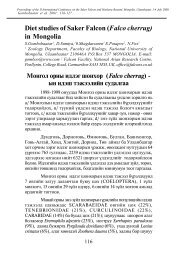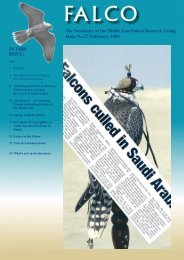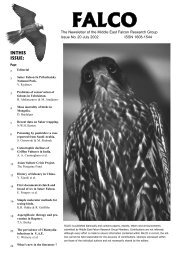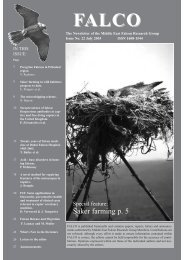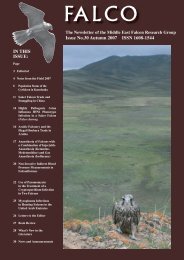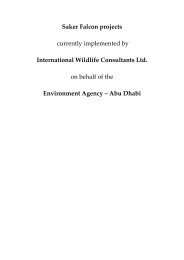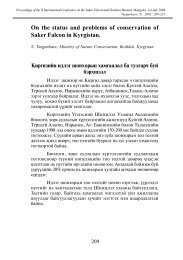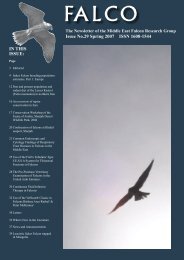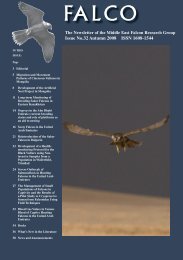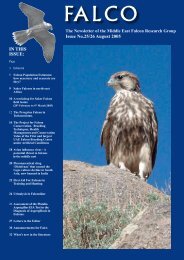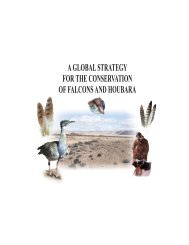Falco cherrug - International Wildlife Consultants Ltd.
Falco cherrug - International Wildlife Consultants Ltd.
Falco cherrug - International Wildlife Consultants Ltd.
Create successful ePaper yourself
Turn your PDF publications into a flip-book with our unique Google optimized e-Paper software.
Saker <strong>Falco</strong>n (<strong>Falco</strong> <strong>cherrug</strong>) in Russia.<br />
I. Karyakin*, L. Konovalov*, A. Moshkin*, A.<br />
Pazhenkov**, I. Smelyanskiy*** and A. Rybenko***.<br />
* Center of Field Studies, Nizhniy Novgorod, Russia<br />
Ikar_Research@mail.ru<br />
**Center for HELP f the Volgo-Ural Ecological<br />
Network, Samara, Russia<br />
***Siberian Ecological Center, Novosibirsk, Russia.<br />
The Saker (<strong>Falco</strong> <strong>cherrug</strong>) is one of the most<br />
endangered falcon species in North Eurasia. In the past<br />
three decades its range and numbers have been declining at<br />
an alarming rate. The species is a typical representative of<br />
arid zone ecosystems and in Russia it occurs at the extremes<br />
of its range.<br />
In this paper we review the recent state of the<br />
Saker in the central part of Southern Russia (between the<br />
Volga and the Yenisey Rivers).<br />
Methods<br />
The region under question occupies the southeast<br />
of the Russian plain (all of Zavolzhye, places eastwards<br />
from the Volga, and all of the southern Urals), the southern<br />
area of western Siberia, and the mountains of southern<br />
Siberia (Altay – Sayan Region). The total area of steppe and<br />
forest-steppe biome suitable for Sakers to breed covers<br />
1,084,035 km 2 (Figure 1). This territory was surveyed by<br />
the authors in 1994-2003. The total size of the expedition<br />
surveys within the areas of possible breeding was 72,721<br />
km 2 . Breeding territories of Sakers were found mostly during<br />
surveys of open habitats using cars, but some were<br />
located during foot surveys. The search pattern was based<br />
on known and recorded hunting birds, and a search for nesting<br />
structures in suitable breeding habitats .<br />
Nesting territories are understood in this paper to<br />
be places occupied by Sakers with either an active or nonactive<br />
nest; with fledglings; or with adults that have been<br />
recorded giving alarm calls or showing aggressive behaviour<br />
towards humans or other raptors. A territory was considered<br />
as ‘possibly occupied’ if adult birds were recorded<br />
delivering food several times in one area.<br />
There were several study areas established in the<br />
region; all of which were thoroughly surveyed for the presence<br />
of all raptor species, with exceptional attention being<br />
paid to the Saker. All nest sites were mapped using Arcview<br />
GIS 3.2a software (ESRI, Redlands, California, USA) from<br />
which we calculated the overall numbers (Karyakin 1996,<br />
2000). On the basis of the mapped nests within the study<br />
areas, we modelled typical nesting habitats using satellite<br />
imagery (Resurs-MSU-E, Landat7) and vectorised topomaps<br />
(1:200,000) and plotted nest-worthy Saker habitats<br />
within the region in question. The numbers were then<br />
extrapolated using the densities observed within the surveyed<br />
study areas.<br />
Historic records of the Saker<br />
The most northerly-located nests sites in Russia<br />
were reported in the past in the sub-taiga regions of the<br />
Krasnoyarsk District (c. 56 0 N). Breeding Sakers (with 4<br />
chicks) were reported: close to Krasnoyarsk (Kim 1988);<br />
along the Bazaikha river, a tributary of the Yenisey near<br />
Divnogorsk within the area of Krasnoyarsk Water Reservoir<br />
(Yudin 1952, Polushkin 1988); at the Karaulnaya (a tributary<br />
of the Yenisey); on Otdykha Island on the Yenisey close<br />
to Krasnoyarsk (in 1976); and finally, close to Dononovo<br />
village, 50 km north of Krasnoyarsk (Baranov 1998). In the<br />
Krasnoyarsk environs in 1980 the density of Sakers was<br />
reported as being 1-2 pairs per 100 km of the survey area;<br />
in the Kizir-Tuba (Kuraginskiy region) density was 4-5<br />
pairs per 100; in the Usinskaya depression 2-3 pairs per 100<br />
km; and in the Sharipov region (close to the Bolshoye Lake)<br />
1-2 pairs per 100 km of the survey area (Baranov 1988).<br />
At the beginning of the 20 th Century Sakers were<br />
recorded at Balkatiskoe village, Achinsk region; at<br />
Altayskaya village in the Khakassia steppes; at Salbat Lake,<br />
at the Minusinsk deprression; and at Bozhye Lake (Sushkin<br />
1914). In the second half of the 20 th century they were<br />
recorded in the Minusinsk depression, in the foothills of the<br />
Eastern Sayan, and in particular, in the territory of the<br />
Sayano-Shushenkiy Nature Reserve (Sokolov et al. 1983).<br />
In the 1990s Saker breeding within the Reserve was reported<br />
as follows: on a 55 km stretch of the Yenisey river, down-<br />
Figure 1 Black lines - Borders of Districts of the Russian Federation. 1- Northern border of the Saker range in Russia. 2 -<br />
Historic range of the Saker. 3 - Recent range of the saker. Numbers of the districts are the same as in Table 1.<br />
3



